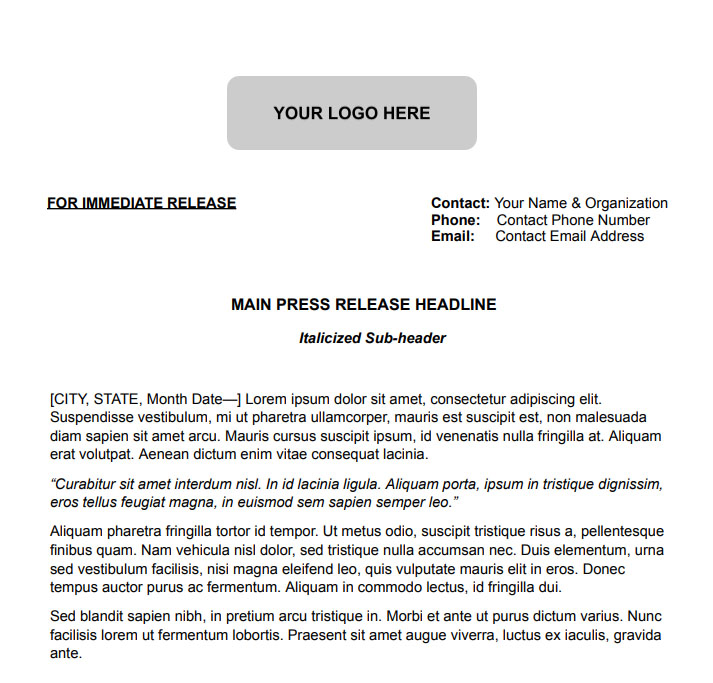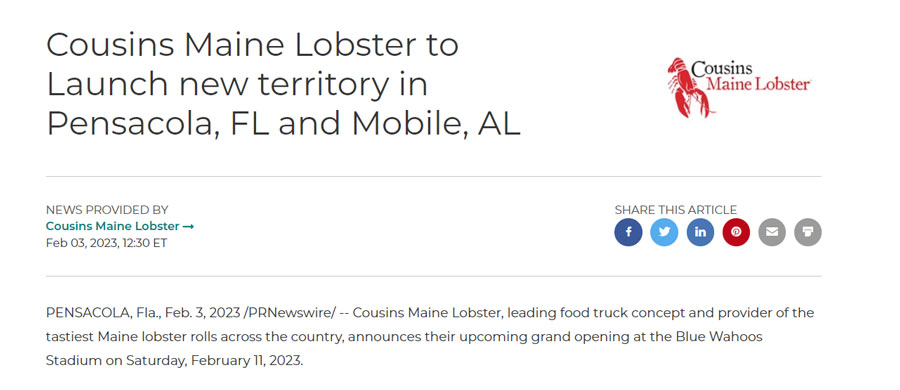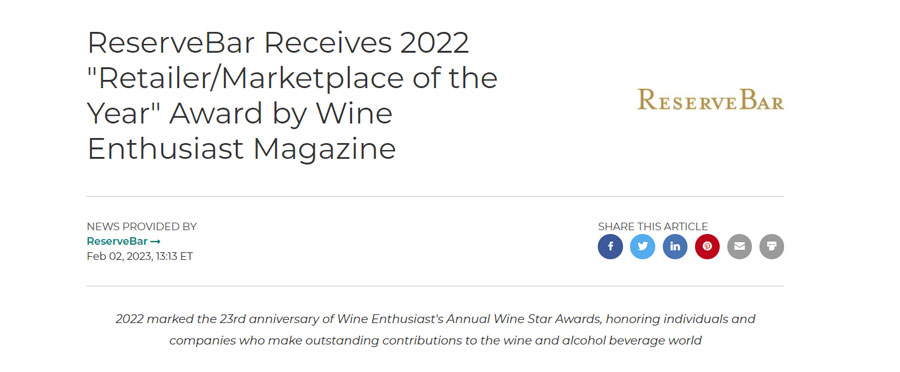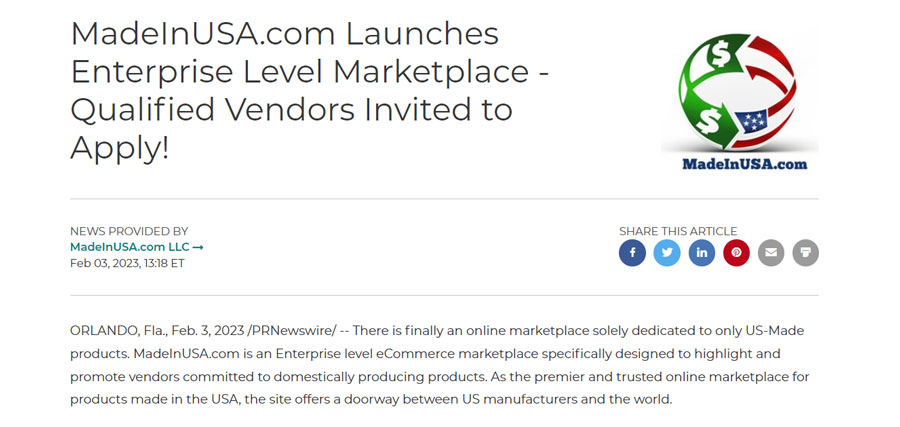Creating a press release is both art and science. For example, you’ll need to develop a newsworthy angle, but you also need to make it easy for journalists and media outlets to cover. It needs to be engaging and well-written, but also formatted according to industry standards. Keep reading to learn how to write a press release, get tips on writing one effectively, and download our free template to get started.
Free Press Release Template
To simplify the process of creating a press release, download our free template below, which is already formatted according to industry standards.
Then, keep reading below to learn how to write a press release in seven steps.
Step 1: Develop a Newsworthy Angle
The most important part of writing an effective press release that builds your brand presence is identifying and developing a newsworthy angle. This means identifying the part of your story that’s most relevant to your target audience. This is important because your story needs to be worth covering to get picked up by journalists.
To help you identify your story’s newsworthy angle, you can ask yourself questions like the following:
- How will this story or announcement affect your audience?
- How relevant is your story to your audience’s needs or interests?
- What can audiences do after reading your story?
For the most part, identifying your story’s angle will come naturally, as press releases are typically only sent during important announcements or updates, like grand openings or business acquisitions. In fact, here are some of the most common types of press release announcements:
- Grand opening announcements
- New store locations
- Key new hires (usually chief executives or directors)
- Publication launches like a book or online magazine
- High-profile corporate events
- Major product or service launches or updates
- Industry breakthroughs or disruptions
- Rebranding initiatives
- Mergers and acquisitions
- Charity projects
- Crisis management announcements
- Business milestones and anniversaries
Part of identifying your press release angle effectively is knowing your target audience. This is important because your audience guides every part of your press release, from its headline to its call to action. Everything should be tailored to their interests and needs.
It helps if you already have an ideal customer profile for your brand with your audience’s characteristics, behaviors, needs, and problems. Knowing these details will help you craft a more focused, relevant story that is more likely to get picked up by journalists.
When defining your audience, here are the most important details to keep in mind:
- Demographics like age range, gender, and location
- Lifestyle factors such as education, home values, or income
- Shared interests, preferences, and activities
- Professional aspects like industries, job titles, or functions
- Behaviors like pain points or purchasing motivators
Step 2: Identify the Main Points of Your Story
When learning how to write a press release, the most important part is your story. Your story needs to immediately capture journalists’ attention. While the best way to do that is by developing a newsworthy angle, as discussed above, the other important part is by clearly identifying your story’s most important points.
Think of it as creating an outline for your story. Because you’re writing a newsworthy announcement, identify the most important points that would have the most impact on your target audience and, therefore, your target journalists.
For instance, if you were writing a press release about a new line of products you’re launching, here are the most important points you’ll likely highlight most in your story:
- The names of your new products
- What they do and other product details
- When they’re launching
- Where people can buy them
- Why people should buy them (aka how people will benefit from buying them)
In many cases, the most important points of your story are the who, what, where, why, and how, as in the example above. However, they can also differ depending on your story. For example, if your press release is about a new study your business published, you might highlight the most important findings of the study and how they affect your audience.
Identifying these main points will help you write a clearer, more impactful story.
Step 3: Write Your Lead and Supporting Paragraphs
In novel writing, authors often try to keep the reader guessing right up until the end. In press release writing, it’s the complete opposite. You want readers to instantly know the most important points of your story in your first paragraph. This is also known as the “lead,” which is a concise summary of your story. It should be about two or three sentences and give the reader the crux of the announcement while intriguing them enough to keep them reading.
Then, in the continuing paragraphs, discuss those points in more detail, and include quotes from one or two key personalities to offer a well-rounded piece with different perspectives. Add hyperlinks, images, and data to back up your points and to make your announcement more interesting or insightful. In all, try to keep the body section to 500 words or less.
For instance, take a look at this example of a press release from Fit Small Business. In the first paragraph, right under the headline and subheadline, is the lead, which summarizes the entire announcement. This is then followed by more details of the story, including quotes and an infographic.
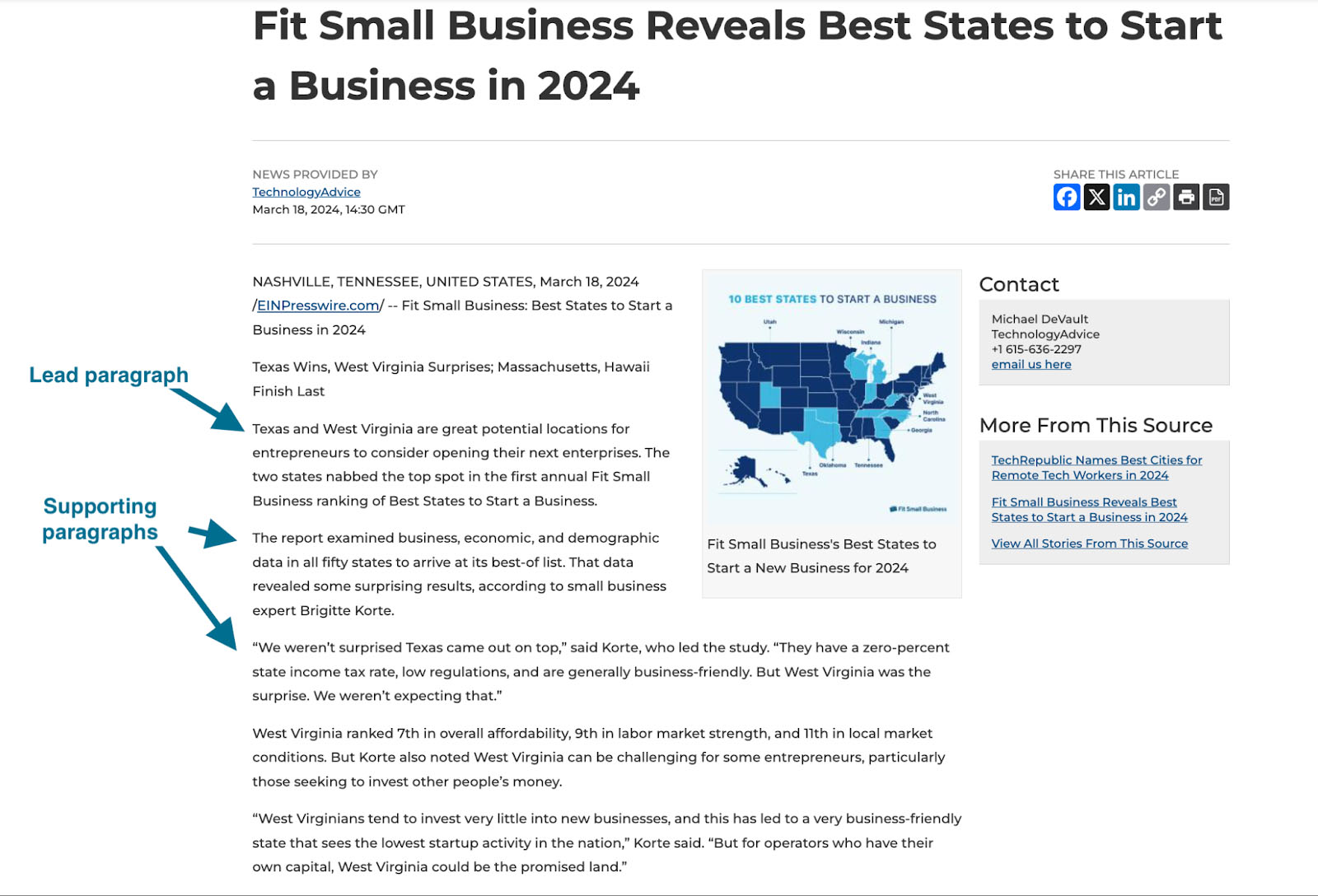
Here’s an example of a press release from this website, with a lead paragraph and supporting details. (Source: Fit Small Business)
Step 4: Craft a Concise, Compelling Headline
Every good press release has an attention-grabbing (but not clickbaity) headline. It’s crucial to make your headline interesting and engaging, as it could be the only thing journalists read when deciding whether or not to cover your story. Your headline should communicate to readers what your story is and why it’s relevant and noteworthy—all in about 60 characters or less.
Here are some tips for writing effective press release headlines:
- Be concise and straightforward.
- Mention your story’s most significant detail.
- Use language that elicits emotion or creates intrigue.
- Be timely or time-sensitive.
- Identify a point of difference (such as a unique feature).
- Mention trends and statistics.
- Showcase your audience’s shared interests or favorite causes.
- Appeal to readers’ “fear of missing out” (FOMO), such as a time-limited or exclusive opportunity.
To learn how to write a press release headline, take some time to gain inspiration from other news stories similar to yours. This will help you improve your own press release’s headlines and story. Below are some press release headline examples that do an excellent job of showcasing their story angles:
In addition to your headline, include a subheadline in italics for up to 120 characters. This allows you to expand on your angle, identify your audience, and give additional context to the headline to intrigue journalists and readers. Read our list of press release best practices for more tips.
Step 5: Add a Boilerplate
After writing your press release story, the next step is adding a boilerplate at the bottom. This is important because it’s where readers can reach out to learn more about your business. Think of this as an “about us” section. It should not only include a short description of what your business does, but also have additional details that expand your story’s angle.
Here are some details you can include in your press release boilerplate:
- Your company’s length of time in business
- The name of your founder or key operating officers
- Your business’s mission, vision, and core values
- Awards and accolades
- Patents or industry breakthroughs
- Company size or market share
- Main product, service, or audience
- Company location or communities served
- A link to a video advertorial or overview of your business
- A link to your website’s media page or press kit
- More media files for your story (like links to images, videos, etc.)
To get a better idea, here’s an example of a press release boilerplate from the Fit Small Business press release above:
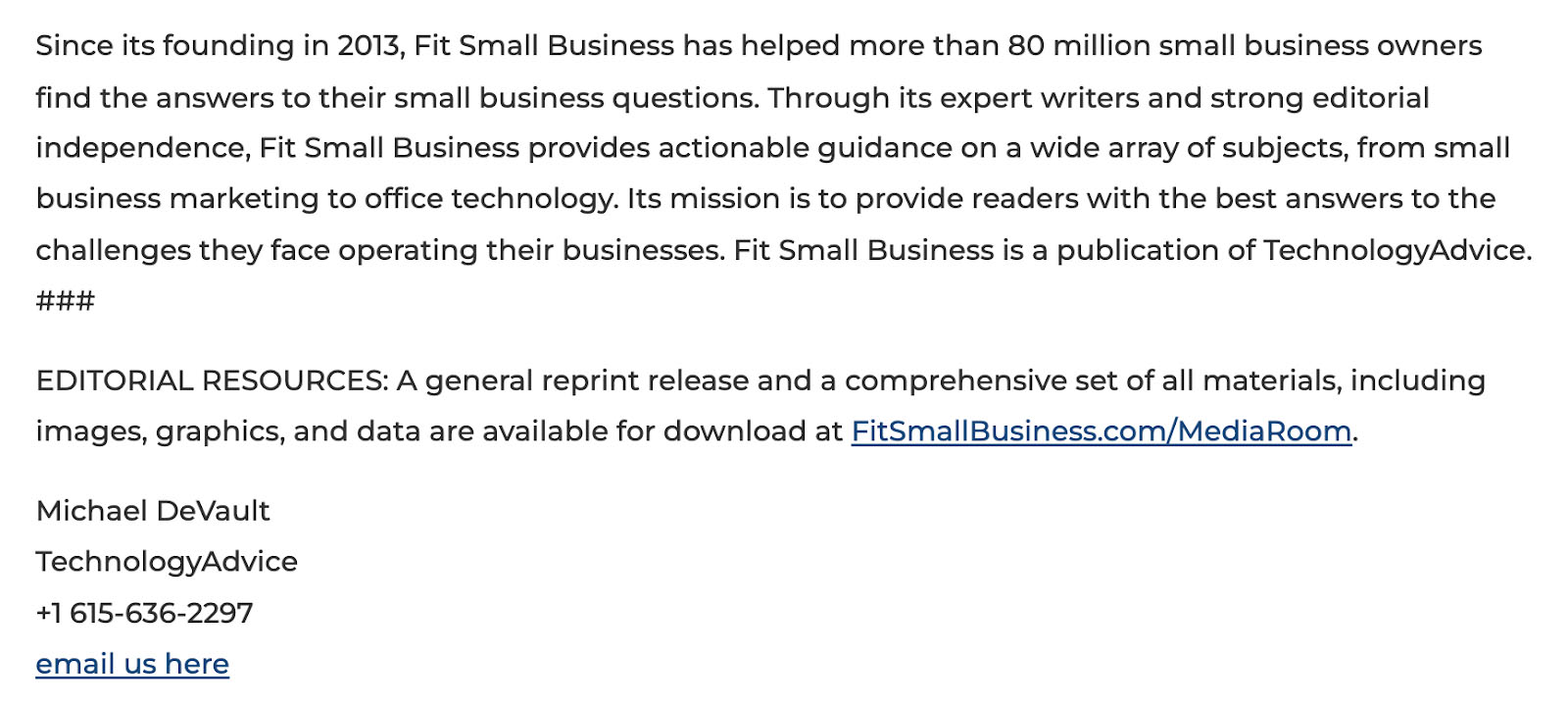
Here’s an example of a boilerplate from Fit Small Business’s press release. (Source: Fit Small Business via EIN Presswire)
Boilerplates also offer value to journalists looking to provide additional coverage. For a step-by-step guide and examples to help you fully leverage this section, read more about how to write a boilerplate.
Step 6: Format Your Press Release
Once your press release story is written, the last step before sending it off for distribution is ensuring it follows proper press release formatting. Press releases are an official and established PR document, and journalists expect them to follow certain formatting standards that you also need to follow to be taken seriously.
If you downloaded the press release template above, your press release will already be formatted to industry standards. If you haven’t, it’s a good idea to double-check your document to ensure everything is in the right place. At the very least, your press release should have your logo, release date, contact information, headline and subheadline, boilerplate, and your story.
Here’s an example of how a proper press release should be formatted:
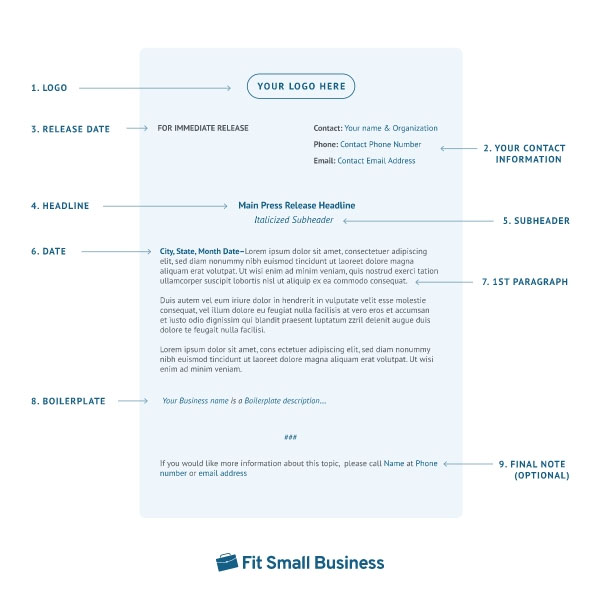
There are nine main parts of a press release format, from your logo to your boilerplate.
Step 7: Distribute Your Press Release
The last step in creating a press release is sending it to the press. There are several ways to do this, but the best way is via a press release distribution service. These services already have connections with hundreds (or even thousands) of news outlets and journalists and are your best bet at landing your story on the local news.
Here are some of the best press release distribution services for small businesses:
Affordable mass media placements and same-day distribution | Best for targeted distribution by location or industry | Combined writing and distribution services; also sends to influencers |
Plans from $99.95 | Plans from $349 | Plans from $399 |
Alternatively, if you’re budget-constrained, there are also free press release distribution services available—although they have significant limitations like word counts or the number of news outlets you can reach.
The final option is distributing your press release manually. Do this by building a contact list of journalists and emailing your press releases individually, although this can also take lots of time and effort.
Next Steps After Publishing a Press Release
After sending out your story, it’s also your responsibility to keep track of its progress and if it gets picked up by any media outlets. Most distribution services have tracking dashboards that keep you updated about your press release’s progress—be sure to ask. Then, follow these next steps after distributing and publishing your press release to maximize its effectiveness:
- Track placements and engagement: As mentioned, most press release services provide distribution reports, including media outlets where your story was syndicated, views, clicked links, and other engagements. For manual distribution, include trackable links and use listening tools like Sprout Social to find out when and where your brand is mentioned online.
- Share online: To increase your reach, share your press release on your website and social media. When sharing on social media, use relevant hashtags and audience targeting, and @ mention the media outlet or journalist in your caption.
- Track performance: Measure analytics like views, engagement, traffic sources, search visibility, audience locations, click-through traffic, and social media shares. If you use a distribution service, these analytics will also come with your report. Use this data to target your future press release distribution strategies more accurately.
- Foster ongoing relationships with journalists: Building relationships with journalists who cover your news creates a win-win situation. They can turn to you as a trusted source for future stories, and you get more coverage for your business.
Press Release Writing Tips
Learning how to write a press release that gets picked up and published is both art and science. Over time, you’ll get better at writing releases that capture journalists’ attention and get your business noticed. That said, there is no one-size-fits-all method for creating top-notch press releases, except that they should always be relevant to your audience. Still, here are some tips I’ve learned over the years on creating good press releases:
- Make your story simple and scannable. No one—not even journalists—wants to open a document that reads like a thesis paper. Journalists receive dozens of story pitches a day, and they only have a few minutes to read yours. So, make sure they get the most important points of your story as soon as they open your document. Use simple sentences and short paragraphs.
- Optimize your press release for search. If your story gets published, it’ll likely be on an online platform like news outlets’ websites. That means to increase its discoverability, it’ll need to be optimized for search engines. The best way to do this is by incorporating search-friendly keywords into your text.
- Get help from tools and services. If you need help writing your press release, you don’t have to go it alone. For instance, there are dozens of press release writing services where experts can write your press release for you at affordable prices. Or, you can also use an AI press release generator to generate a press release draft that you can edit and customize.
- Be informative, not sales-y. One of the biggest press release mistakes is treating your document like a marketing or sales pitch and making it all about your brand. It’s important to remember that your press release is, first and foremost, a news story. Therefore, it should be informative, helpful, and factual—not promotional.
- Tailor your pitch to each journalist or media outlet. Your pitch is the email you send to journalists introducing your press release. It makes a world of difference when the pitch journalists read feels genuinely tailored to their work and audience, instead of a generic one they can tell is sent to hundreds of others. Take time to understand the audience of the media outlets you’re pitching to.
Find out more tips in our list of 18 press release best practices. Plus, learn how to distribute a press release effectively to journalists.
Frequently Asked Questions (FAQ)
The seven essential parts of a press release are its heading, subheading, release date, brand logo, contact information, press release body (with a lead paragraph), and boilerplate. Additionally, you can also include a final note at the very bottom of your press release to indicate who journalists and readers can contact for more information on your story.
The seven steps to creating a press release include developing a newsworthy angle, identifying the main points of your story, writing your lead and supporting paragraphs, crafting a compelling headline, adding a boilerplate, formatting your press release, and finally, distributing it to news outlets. After distribution, you can also track your press release pickups and share your published press release on your brand’s website and social media accounts.
The proper press release formatting should start with your logo at the very top of the document, followed by the release date and your contact information. Then, your press release headline and subheadline should go right below, followed by the main body of your press release, beginning with its date and location. After your press release body, add a boilerplate with information about your company and, optionally, a final note.
Bottom Line
Press releases are an established way for businesses and journalists to communicate and benefit from one another. Learning how to write a press release mainly involves identifying a relevant, newsworthy angle for your audience, writing an informative and compelling story, and following proper industry formatting and standards. Good press releases can increase your brand’s recognition and credibility among the wider public.
If you need professional help writing your press release, the experts at EIN Presswire have lots of experience working with small businesses. They’re one of our top press release services overall, and they can edit and distribute your press release to thousands of media outlets at affordable prices.
